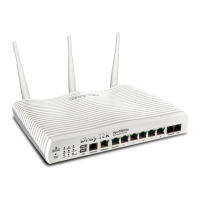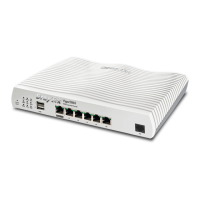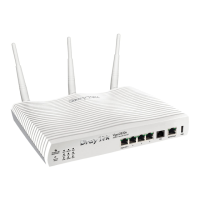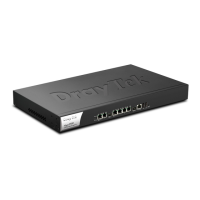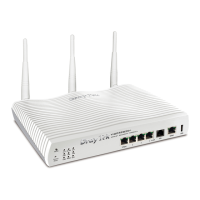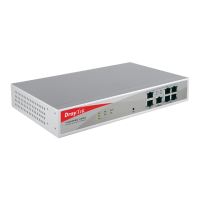Do you have a question about the Draytek Vigor2860 Series and is the answer not in the manual?
| Firewall Type | Stateful Packet Inspection (SPI) |
|---|---|
| VPN Support | IPSec, PPTP, L2TP, SSL VPN |
| DoS Protection | Yes |
| Intrusion Prevention System (IPS) | Yes |
| LAN Interfaces | 4 x Gigabit Ethernet |
| User Authentication | Local, RADIUS, LDAP |
| VPN Tunnels | 32 |
| Management Interface | Web-based, CLI |
| Concurrent Sessions | 50, 000 |
| Content Filtering | URL Keyword Filtering, Web Content Filtering |
Guides users through the physical setup and connection of the Vigor router and associated devices like printers.
Details Wide Area Network (WAN) concepts, including Internet Protocol basics, public/private IP addresses, and connection methods like DSL and 3G/4G USB modem.
Explains how to configure WAN settings for various access modes like ADSL, VDSL, Ethernet, USB, LTE, PPPoE, and Static IP.
Explains Local Area Network (LAN) concepts, NAT function, and how to configure IP subnets, including the use of Virtual LANs.
Explains Network Address Translation (NAT) and its benefits, including cost savings and enhanced security by obscuring private IP addresses.
Explains High Availability (HA) feature for component failure awareness and backup resource management, ensuring continuous service.
Explains routing strategies including Route Policy (PBR), Load Balance, Specify Interface, Address Mapping, Priority, and Failover mechanisms.
Details configurations for Load Balance and Route Policy, enabling traffic distribution and custom routing rules for optimizing network performance.
Covers LTE WAN functionality for convenient internet access via SIM card, including SMS related operations for status reporting and remote control.
Covers wireless LAN configurations for "n" models, detailing operation modes, channel settings, and security options.
Details wireless security settings for WPA and WEP, including pre-shared keys and encryption modes for secure wireless connections.
Explains Voice over IP (VoIP) network usage, enabling toll-quality voice calls over the internet, supporting SIP protocol.
Details how to set up SIP accounts, register with SIP registrars, and configure call signaling protocols for VoIP communication.
Allows configuration of phone book, digit map, call barring, regional settings, and PSTN setup for VoIP function, simplifying call management.
Explains Virtual Private Network (VPN) technology for secure connections across networks, suitable for remote access and site-to-site communication.
Guides users through configuring VPN client settings, creating LAN-to-LAN profiles for outgoing VPN connections.
Assists in configuring VPN server settings, allowing creation of LAN-to-LAN profiles for incoming VPN connections.
Explains IPsec General Setup, covering Phase 1 and Phase 2 configurations, authentication methods, and security protocols for secure tunnels.
Describes managing remote user profiles for VPN dial-in access, allowing authentication via various methods and setting connection parameters.
Explains how to manage LAN-to-LAN VPN connections, setting up profiles for dial-in/dial-out, connection types, and security methods.
Covers VPN trunk features like backup, load balance, GRE over IPsec, and binding tunnel policy for robust and flexible VPN management.
Explains SSL VPN, a secure VPN form usable with standard web browsers, offering benefits like no client software installation and fewer restrictions.
Covers managing digital certificates, including generating, importing, and managing local and trusted CA certificates for secure VPN connections.
Explains firewall facilities including user-configurable IP filters, Stateful Packet Inspection (SPI), and DoS/DDoS attack protection for network security.
Allows adjustment of IP Filter and common options, including enabling/disabling Call Filter or Data Filter, and setting serial filter sets for traffic control.
Guides users on editing or adding filter rules within filter sets, specifying direction, IP addresses, protocols, and actions for packet filtering.
Explains Denial of Service (DoS) Defense functionality to detect and mitigate various attack types by inspecting packets against an attack signature database.
Covers Central Security Management (CSM) for controlling IM/P2P usage, filtering web content, and managing URL content for enhanced network security.
Guides users on activating and configuring URL Content Filter (WCF) to limit access to objectionable websites and prevent malicious code downloads.
Details Web Content Filter (WCF) activation and profile settings to protect businesses from threats like inappropriate content and malicious downloads.
Covers essential system setup and maintenance tasks, including System Status, TR-069, password management, and firmware upgrades.
Provides basic network settings of the Vigor router, displaying LAN and WAN interface information, firmware details, and connection status.
Guides users on setting and changing the administrator password for secure access to the router's web interface.
Details how to back up and restore router configurations, enabling easy transfer of settings to Vigor2860 series devices or for recovery purposes.
Covers management settings for Internet/LAN access control, port setup, TLS/SSL encryption, CVM access, and device management for secure remote access.
Details the process of upgrading router firmware to the latest version for improved functionality, security, and bug fixes.
Details managing network bandwidth through Sessions Limit, Bandwidth Limit, and Quality of Service (QoS) settings to ensure optimal performance for critical applications.
Explains how to limit the number of concurrent sessions for hosts to manage resource usage and prevent performance degradation, especially for P2P applications.
Covers setting upstream and downstream bandwidth limits for LAN computers and subnets, optimizing network resource allocation.
Details Quality of Service (QoS) management for prioritizing traffic, classifying applications, and scheduling packets to ensure service levels and sufficient bandwidth.
Provides a security feature to manage hosts by user account, allowing different firewall rules and policies for various users.
Determines user management standards (Rule-Based or User-Based), influencing how firewall rules are applied to users and controlling internet access.
Guides users on setting customized profiles for users, defining access authorities, authentication methods, and connection limitations.
Details central VPN management for building virtual private networks, covering CVM settings, IPsec VPN, and managing remote devices.
Explains how to manage connected CPE devices, including device discovery, maintenance tasks like firmware upgrades, and configuration backup.
Provides an overview of VPN connections and management, allowing users to view connection status, initiate dial-out, and manage VPN tunnels.
Details Central AP Management features, including AP Map for placement optimization, AP Maintenance for remote management, and Load Balance for traffic distribution.
Guides users through troubleshooting common issues like inability to access the internet by checking hardware, network settings, and ISP configurations.
Displays DoS/DDoS attack information detected by the firewall, helping to identify and block malicious traffic to protect the network.
Details how to reset the router to factory default settings via software or hardware, a crucial step for resolving persistent configuration problems.
